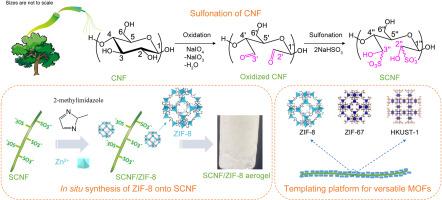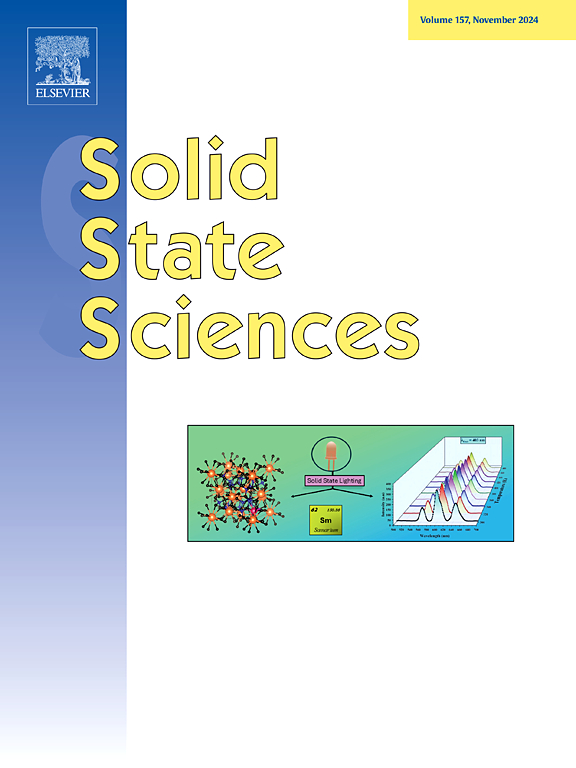在磺化纤维素纳米纤维上原位合成金属有机框架
IF 3.4
3区 化学
Q2 CHEMISTRY, INORGANIC & NUCLEAR
引用次数: 0
摘要
尽管金属有机框架(MOFs)颗粒具有高比表面积和多孔结构,但其固有的脆弱性和较差的可加工性往往限制了其功能性应用。我们研究了磺化纤维素纳米纤维(SCNF)作为生物聚合物模板与 MOFs 杂交的可行性。SCNF 是通过高碘酸氧化法合成的,然后进行亚硫酸氢盐磺化。磺酸盐基团增加了电负性,提高了纤维素纤维的分散性。更重要的是,带负电荷的磺酸盐可以作为金属离子的锚定物,启动 MOFs 沿纤维素纤维表面的原位生长。我们已经合成了三种 SCNF/MOF 混合物,即 SCNF/ZIF-8、SCNF/ZIF-67 和 SCNF/HKUST-1。这些混合物可以形成独立的气凝胶,具有显著的高比表面积和应用灵活性。对 SCNF/ZIF-8 混合物吸附效率的评估表明,与 SCNF 对照组相比,混合物材料对亚甲基蓝的吸附能力明显更高。DFT 计算进一步揭示了潜在的吸附机制,发现 SCNF 上的磺酸盐和 ZIF-8 配体中的氮原子是亚甲基蓝亲和力的主要来源。SCNF 提供了一种多功能、坚固耐用的生物聚合物基质,可用于模板化各种 MOFs,在吸附剂及其他方面具有广阔的应用前景。本文章由计算机程序翻译,如有差异,请以英文原文为准。

In situ synthesis of metal-organic frameworks on sulfonated cellulose nanofibrils
The intrinsic fragility and inferior processibility of metal-organic frameworks (MOFs) particles often restrict their functional application despite their high surface area and porous structure. We investigated the feasibility of sulfonated cellulose nanofibrils (SCNF) as a biopolymer template to hybridize MOFs. SCNF was synthesized through periodate oxidation followed by bisulfite sulfonation. The sulfonate groups increased electronegativity and enhanced the dispersibility of the cellulose fibers. More importantly, the negatively charged sulfonates could serve as anchors for metal ions to initiate the in situ growth of MOFs along the surface of cellulose fibers. We have achieved the synthesis of three types of SCNF/MOF hybrids, namely, SCNF/ZIF-8, SCNF/ZIF-67, and SCNF/HKUST-1. These hybrids can be formed as free-standing aerogels, exhibiting remarkably high surface areas and flexibility for applications. The assessment of the adsorptive efficiency of the SCNF/ZIF-8 hybrid indicates that the hybrid material exhibited a notably higher adsorption capacity for methylene blue versus the SCNF control. DFT calculation provides further insights into the underlying adsorption mechanisms, revealing that the sulfonates on the SCNF and the nitrogen atoms in the ZIF-8 ligands primarily contributed to the affinity for methylene blue. SCNF offers a versatile and robust biopolymer substrate for templating a wide array of MOFs with promising applications as adsorbents and beyond.
求助全文
通过发布文献求助,成功后即可免费获取论文全文。
去求助
来源期刊

Solid State Sciences
化学-无机化学与核化学
CiteScore
6.60
自引率
2.90%
发文量
214
审稿时长
27 days
期刊介绍:
Solid State Sciences is the journal for researchers from the broad solid state chemistry and physics community. It publishes key articles on all aspects of solid state synthesis, structure-property relationships, theory and functionalities, in relation with experiments.
Key topics for stand-alone papers and special issues:
-Novel ways of synthesis, inorganic functional materials, including porous and glassy materials, hybrid organic-inorganic compounds and nanomaterials
-Physical properties, emphasizing but not limited to the electrical, magnetical and optical features
-Materials related to information technology and energy and environmental sciences.
The journal publishes feature articles from experts in the field upon invitation.
Solid State Sciences - your gateway to energy-related materials.
 求助内容:
求助内容: 应助结果提醒方式:
应助结果提醒方式:


